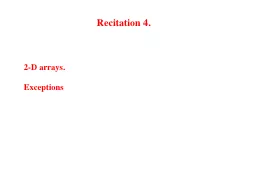PPT-Recitation 10
Author : stefany-barnette | Published Date : 2017-09-07
Prelim Review Big O See the Study Habits Note 282 on the course Piazza There is a 2page pdf file that says how to learn what you need to know for Onotation Big O
Presentation Embed Code
Download Presentation
Download Presentation The PPT/PDF document "Recitation 10" is the property of its rightful owner. Permission is granted to download and print the materials on this website for personal, non-commercial use only, and to display it on your personal computer provided you do not modify the materials and that you retain all copyright notices contained in the materials. By downloading content from our website, you accept the terms of this agreement.
Recitation 10: Transcript
Download Rules Of Document
"Recitation 10"The content belongs to its owner. You may download and print it for personal use, without modification, and keep all copyright notices. By downloading, you agree to these terms.
Related Documents














